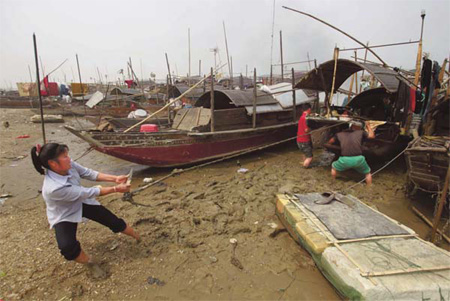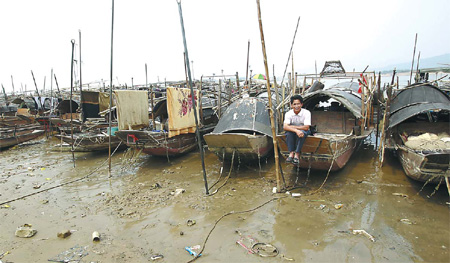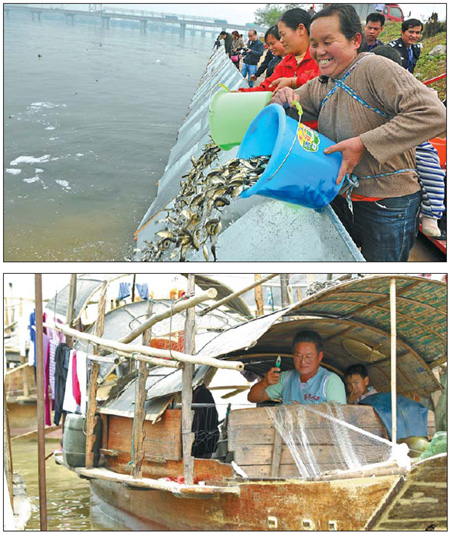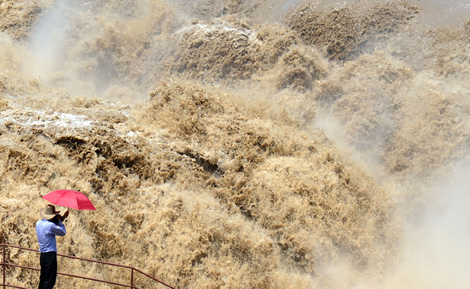

Tide is hopefully turning in bid to boost stocks, reports Qiu Quanlin in Guangdong province.
Wei Lizhen, 59, usually casts her fishing nets on the Xijiang River around 5 am. The villager from Zhaoqing, Guangdong province, has been fishing on the tributary of the Pearl River for more than 30 years.
 A boat is secured at Sanshui, Guangdong province, following a two-month fishing ban to revive declining stocks in the Xijiang River. Zou Zhongpin / China Daily |
But in recent years stocks declined and her daily catch was reduced to about 5 kilograms of fish after nearly 10 hours in a tiny boat. "I caught at least 20 kg a day a decade ago," she said.
"There are fewer fish - individuals and species - due to overfishing in recent years. The common species such as carp, catfish and grass carp are now rarely seen in the river."
Overfishing has become a serious problem on the Pearl River. "It is like a small cake for many people. I can only have a tiny slice."
Wei's hope for a bigger cake might be realized in the years ahead as a result of a fishing ban, the first to encompass an entire river system, on the Pearl. The Ministry of Agriculture imposed the annual two-month restriction on April 1, the start of the peak spawning season.
The goal is to preserve biodiversity and improve water quality in China's third longest river, which includes the tributary Xijiang, Beijiang and Dongjiang rivers. The ban also covers related lakes in Jiangxi, Hunan, Guizhou, Yunnan and Guangdong provinces and Guangxi Zhuang autonomous region.
"I hope that the ban will help restore the number of fish in the river," Wei said.
A toll on the Pearl
The Pearl River, stretching 2,400 kilometers, was once home to nearly 400 varieties of fish, including such rare species as the Chinese sturgeon and the giant salamander. It contained about half of the country's freshwater species.
 A fisherman relaxes along the Sanshui section of the Pearl River. Fishing boats won't be going out again until June 1, after a two-month fishing ban on the entire river system expires. Zou Zhongpin / China Daily |
But years of overfishing, water pollution and increasing construction of hydro projects have led to a decline in fishing output and some rare species have not been seen for years, said Wu Zhuang, director of South China Sea Fishery Bureau under the Ministry of Agriculture.
For example, there have been no recorded catches of Chinese sturgeon in recent years. In the 1930s, some 400,000 kg of the sturgeon were produced each year in the Xijiang River alone.
According to samples collected near the biggest spawning site along the Pearl River, both the number of individual fish and the number of fish species have declined significantly during the past few years, according to a report in Guangzhou Daily.
Anadromous fish, which live in the sea but swim upriver to reproduce, "have been forced to spawn before arriving at the best sites ... because traditional grounds are blocked by hydro projects", researcher Li Xinhui was quoted as saying. "As a result, their young have slimmer chances of surviving, largely because their migration routes back to the ocean are not long enough to allow them to mature."
Li, who works for the Pearl River Fisheries Research Institute under the Chinese Academy of Fishery Sciences, also attributed the decline in the numbers of many common freshwater fish to changes in the aquatic environment.
Dealing with dams
To maintain the diversity of aquatic species in the river, Li suggested that dam projects make accommodations that allow fish to migrate and spawn. "For example, separate channels should be built in the dam projects so that fish can move upstream to their spawning sites."
 Top: Fish fry leave buckets for the Yujiang River, a Pearl River tributary in Guangxi Zhuang autonomous region, on the day the fishing ban began. Yu Xiangquan / Xinhua Above: Weaving nets is one occupation fisherman can pursue while they wait to take to the water again. Zou Zhongpin / China Daily |
Yang Shaosong, an official with the fishery bureau, said separate channels would be of little use because they are not like the natural waterways fish are accustomed to. "Fish do not know where the channels are. They may have to spawn downstream if they do not find a waterway upstream," Yang told China Daily.
An estimated 14,000 hydro projects and 96,000 water conservancy works have been constructed along the Pearl River. Most have been in the upper half of most of the tributaries, according to Yang.
"The hydro projects play an important role in supporting the economic development of cities near the river," Yang said, "but they also pose a great threat to the development of freshwater fish, hindering the propagation of some fish species.
"We cannot stop building such projects, nor ask local authorities to destroy them. So we find no way, except to ban fishing, to prevent fish species from dying in the river."
An increasing number of environmental emergencies in recent years have also polluted water and killed fish, Yang said. China's Fishery Eco-environment Report tallied 165 pollution incidents in the Pearl River in 2009, leading to economic losses totaling 56 million yuan ($8.6 million).
For example, many factories in recent years were found to have discharged industrial waste into the upper reaches of Xijiang and Beijiang river tributaries. In 2005, a serious cadmium leak from a factory in Yingde county, on the upper section of Beijiang River, killed many fish and affected nearly 100,000 local people.
Living without fishing
The fishing ban has won support from a vast majority of fishermen, according to sources with the fishery bureau. On April 2, the bureau sent 307 vessels to patrol the Pearl River and found no fishing boats.
The Pearl River supported some 127,000 fishermen in 2009, the fishery bureau said. They used 33,448 fishing boats and brought in 157,000 tons of fish.
"We promoted the ban in advance," Yang said. "Fishermen have shown great support for the move. In return, the move will help fishermen earn more in the near future" because their catches will increase.
But fishermen have more immediate concerns, including how they will live without fishing during the two-month ban. The local fishery authority will work with human resource departments to help fishermen find new jobs. Moreover, each city authority along the Pearl River will offer subsidies to fishermen during the ban period, sources with the fishery bureau said.
Authorities have not announced the amounts. Wei, the fisher from Zhaoqing, said her monthly income from fishing was usually about 1,500 yuan.
"I am too old to go to bigger cities for a better job," she said. "I will stay here and look for an improved fishing condition after the fishing ban."
Other fishermen doubted that two months would produce any positive results in sustaining fish resources. "According to my experience, it would take at least a five-year ban to increase the fishing output significantly," said He Yayou, 65, a fisherman in Zhaoqing.
Local fishery authorities will take additional action to increase the numbers and species of fish. They plan to introduce artificial repopulation measures such as discharging more than 6 million fish fry into the Pearl River. The fry will come from fish farms, Yang said. It will take at least a half-year for some common species, such as grass carp, to grow to catchable size.
First ban in 1995
The temporary fishing ban in the Pearl River system is not the first such move introduced by the government. China started prohibiting fishing in four seas in 1995 and introduced an annual three-month fishing ban on the Yangtze River in 2003.
"The fishing ban on the Yangtze River in the past nine years has proved the effectiveness of such measures," said the fishery bureau's Yang. For example, there was almost no mitten crab output in the Yangtze in 2000, but output surpassed 10 tons in 2007, according to the Ministry of Agriculture.
The ban on the Yangtze affects more than 8,100 kilometers, not the river's full length, and includes Dongting, Poyang and other lakes along the way. It covers 10 provinces and municipalities and affects some 50,000 fishermen.
Some fishermen, such as Hu Zhengbin, said fishery resources have improved. "I recently caught a knife fish, which was rarely seen in past years," he told Xinhua News Agency.
Hu, who is from Wuhan, Hubei province, has relied on fishing for more than 20 years. There were some days in 2002 when he caught no fish, he said. "Some fish, which are usually of great economic value, have returned after almost a decade of the fishing ban on the Yangtze River," he said.
Fishery experts said the ban on China's major rivers and seas should continue in the next decades, given that the rivers contribute less than 10 percent of the country's freshwater fish consumption. About 100,000 tons of freshwater fish come from the Yangtze each year, while the country consumes some 3.5 million tons of such fish, mostly from fish farms.
"We can rely more on aquaculture to produce freshwater fish," said Wang Zhaomin, director of Hubei bureau of aquatic products.
According to Wang, the number of fishermen on the Yangtze has declined in the past decade. Many have found new work with steadier income.
"Only the old fishermen still stayed," Hu said. "The young have gone to big cities for better jobs."
Jin Zhu contributed to this report.







